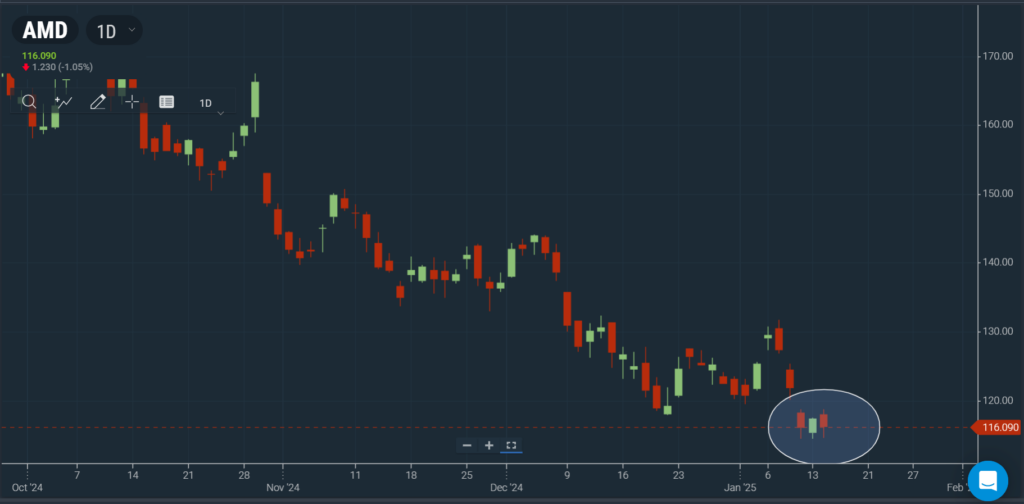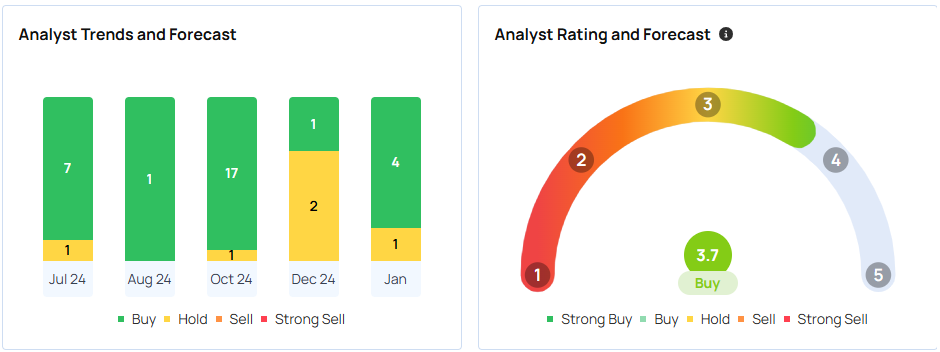Zinger Key Points
- HSBC downgraded AMD on Jan. 8 from 'buy' to 'reduce'.
- This rare candlestick pattern could signal a reversal for the stock.
- Feel unsure about the market’s next move? Copy trade alerts from Matt Maley—a Wall Street veteran who consistently finds profits in volatile markets. Claim your 7-day free trial now.
Shares of chipmaker Advanced Micro Devices Inc. AMD are most likely poised for a reversal as its candlesticks show a rare pattern despite a double downgrade from HSBC on Jan. 8.
What Happened: The semiconductor stock’s candlestick chart shows a unique ‘Bullish Stick Sandwich’ pattern, a technical trading formation suggesting a potential price reversal upwards.
This pattern typically consists of three consecutive candlesticks visually resembling a sandwich on a price chart, as highlighted in the following chart by Benzinga Pro.

A bullish stock sandwich pattern emerges when a bullish candlestick is sandwiched between two bearish ones. This signals potential buying strength amidst a bearish trend.
A larger middle candle strengthens the signal, however, it could also indicate temporary buyer dominance. Confirmation of a reversal comes from subsequent bullish candlesticks, ideally breaking above the prior bearish highs.
The founder of Rock Trading Group, John, said in an X post, “Call me nuts I believe $AMD could outperform $NVDA this year,” sharing the occurrence of the aforementioned pattern.
Furthermore, the technical analysis of daily moving averages shows a weaker picture of the stock.
AMD’s shares closed at $116.09 apiece on Tuesday and it was below its eight-day simple moving average of $121.77 and its 20-day average of $122.83 apiece.
The 50 and 200-day simple moving averages were also above the share price at $132.86 and $151.11, respectively, suggesting a bearish trend.
On the other hand, the relative strength index of 35.51 suggested that the stock could be moderately oversold but still in the neutral zone.
Why It Matters: HSBC’s Frank Lee, downgraded the stock from “Buy” to “Reduce” last week with a 45% reduction in its share price target from $200 to $110 per share.
According to a research note, as reported by GuruFocus, he expects reduced demand for AMD’s MI325 GPU and supply issues with high-bandwidth memory from Samsung. Lee suggested that AMD could face a competitive disadvantage in AI rack solutions until the arrival of its MI400 series, expected in late 2025 or early 2026.
In a research note published Tuesday, Jan. 14, Loop Capital initiated coverage of AMD with a “Buy” rating and a price target of $175. The firm expressed confidence in AMD’s future growth prospects, particularly in the accelerated computing market, reported Investing.com.
Loop Capital highlighted AMD’s potential to gain significant market share in both the data center and PC segments. The firm believes that AMD’s stock, which has underperformed the PHLX Semiconductor Sector index in 2024, is currently undervalued compared to its competitors.
About 31 analysts tracked by Benzinga have a consensus “Buy” rating with an average target price of $184.53 on AMD stock. Keybanc, Loop Capital, and Wells Fargo are among the three most recent analyst ratings, and their average price target stands at $163.33, implying a 41.01% upside.

Price Action: Shares of AMD gained over 0.2% in pre-market hours on Wednesday. The stock has declined by 8.37% over the past month and 26.87% over the last year.
Read Next:
Photo courtesy: Shutterstock
Edge Rankings
Price Trend
© 2025 Benzinga.com. Benzinga does not provide investment advice. All rights reserved.
date | ticker | name | Price Target | Upside/Downside | Recommendation | Firm |
|---|
Trade confidently with insights and alerts from analyst ratings, free reports and breaking news that affects the stocks you care about.